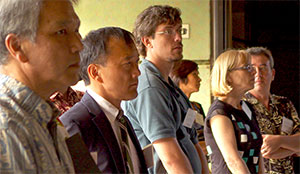UH leads initiative to build state’s multilingual workforce
News Release from UH September 17, 2013
The University of Hawaiʻi is playing a lead role in a major statewide initiative called the Hawaiʻi Language Roadmap. The ultimate goal is identifying Hawaiʻi’s language needs and creating a robust, multilingual workforce to handle those needs. More than 30 languages are already taught at the UH Mānoa College of Language, Linguistics and Literature.
“We have the resources here, we have the expertise here to work with the community, to develop the kinds of programs we need,” said Dina Yoshimi, the program manager for the Hawaiʻi Language Roadmap Initiative and aUH Mānoa Japanese language associate professor.
This is not just about tourism, the state’s number one industry, where multilingual employees have long been in demand.
“It goes way beyond the question of tourism,” said Hawaiʻi Governor Neil Abercrombie. “It goes right to the heart of whether our young people are going to be able to compete and succeed in the 21st century.”
 Hawaiʻi Language Roadmap launch
Hawaiʻi Language Roadmap launch
Representatives from the University of Hawaiʻi, the business community, state agencies, non-profit organizations, and public and private education attended the official launch event at the UH Mānoa Kamakakūokalani Center for Hawaiian Studies.
The Hawaiʻi Language Roadmap is based on input from more than a hundred stakeholder groups who participated in the Hawaiʻi Language Summit in March 2013, along with interviews from Neighbor Island stakeholders. Financial institutions were among the many local businesses that participated.
“We have a shortage actually as it is of people who can speak the various Asian languages because that’s who comes here a lot, said Betty Brow, a Bank of Hawaiʻi Executive Vice President. “If people can’t communicate with us when they come here, eventually, they will not come back.”
The roadmap also identified a tremendous need for Hawaiʻi residents who are not fluent in English.
“We need people who are able to interact with these people effectively in their language, particularly in high stake interactions—medical interactions, legal interactions,” said Yoshimi.
The Hawaiʻi Language Roadmap outlines initiatives and incentives, policies and partnerships that will enable the state to realize the economic and societal contributions of having a strong, multilingual workforce.
“If Hawaiʻi is to fulfill its promise destiny of being an anchor of the Pacific, in the Asia Pacific 21st century, then a multi-language Hawaiʻi is the gateway to success in that century,” said Abercrombie.
For more information, go to the Hawaiʻi Language Roadmap website.